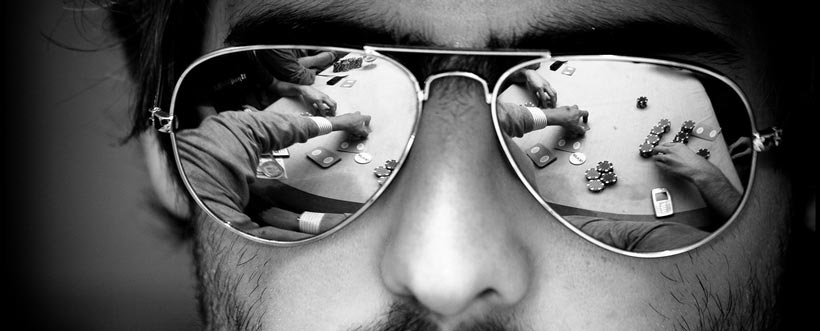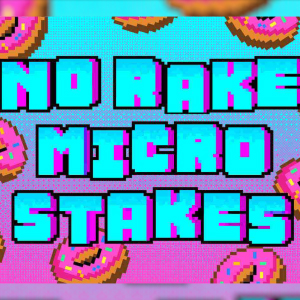Learn proper poker cash game strategy so you can crush live poker regularly. Live poker has some differences from online poker so study up and get an edge.
Many online players will dabble in live play at some point in their poker career. The truth is that if you can hold your own in an online environment,
you can potentially become a huge winner in live games. Playing live poker is
a little like playing online poker 10 years ago, the competition is soft and there is a lot of money to be made, even in higher limit games. If you are planning to hit a live game sometime soon, the following pointers should get you off to a good start.
1. Body Language
 Image Credit - Yanning Van De Wouwer
Image Credit - Yanning Van De WouwerThere is a richness in a live poker game that doesn’t exist in an online game. In an online environment it’s the players with the strongest theoretical knowledge and the best grasp of mathematics that usually come out on top. These skills are doubtless still valuable in a live environment, but there are winning players who are theoretically very weak. Why is this the case?
They understand human psychology and can make strong plays based on various tells that are given off unintentionally.

There is a wide
range of material that can be found online regarding this topic. All kinds of actions should be observed intently. It could be the way an opponent handles his chips, the direction of his gaze, the frequency with which he checks his cards. Perhaps he seems overly casual, or extremely uncomfortable. Perhaps he is talkative at certain times, or silent. Maybe he takes a long time to make certain decisions while acting very quickly in others.
Reading these is an art and takes experience and practice. Remember that an action that indicates one thing about a certain opponent, might indicate something complete different for another. There is no universal meaning to various actions. We are essentially interested in how an opponent acts by default and in which situations he deviates from this.
The idea is that we might find ourselves in a situation where our opponent makes a big bet on the river. In an online environment
we know we’d click the fold button every time. Our opponent freezes, scarcely breathing, making firm eye-contact with us. We know that this player is generally casual, friendly, not prone to starting.
The solid eye contact is often used as a subconscious intimidation tactic, while the reduced movement and breathing is a natural human response to telling a lie or being nervous.
We have a read on him and make the call
because we know he is bluffing. Theoretically our call is terrible, but we win,
because we understand the way our opponents behave.2. Masking

Hidden behind the privacy of our computer screen at home, we don’t need to worry about our opponents picking up visual tells. Now, for the first time, we will need to worry about whether we are
giving away any information for free. There is a chance that the average online player is a walking bucket of tells when he first sits down in a live game.
The key here is consistency.
We don’t want to act one way with our strong hands and another way with our weak hands. We want to think about the timing we use for our decisions. We also might decide to cover our eyes or mouth (with sunglasses or a hoody) to
prevent our opponent from getting body language reads. Masking can be surprisingly hard to do, since there are some factors we may not even consider. For example, perhaps we like to shuffle our chips a lot. When we are bluffing we might subconsciously stop shuffling, or the tempo with which we shuffle increases or decreases.
Perhaps we have a tendency to use a card protector when our hand is strong. Maybe we have a tendency to vocalize our actions when we are strong (“check” “raise”), but let our chips do the talking when we are weak. (Tap table for check, simply place chips
in the middle when betting).
3. Reverse Tells

As we develop proficiency in understanding body language, we can attempt to use it to our advantage. Perhaps we know a certain player will read a specific type of action as weak. Maybe he thinks that if we push our chips forward forcefully it means we are bluffing.
We can consider using this as an advanced tactic to get lighter calls. It’s important to stress that this kind of play requires strong reads. We wouldn’t want to be attempting something like this against a player who is simply not paying any attention and just looking at his own two cards.
We can end up levelling ourselves pretty hard this way. Our default approach should be to keep our actions balanced and stay masked.
4. Local Rules

We get somewhat accustomed to the rules of games online. That might not be exactly how the games run at your local casino. We want to check things such as the blind-structure and any additional rules such as straddling/antes and card showing.
Online the BB is usually double the SB. In a live environment this could be completely different, in some casinos the BB is exactly the same as the SB, leaving the SB the option to simply check to the BB.
Antes may also be in play (usually this means we should raise more aggressively), and some additional rules such as straddling might also be optional. A straddle is when UTG pays an additional payment blind, but then gets to act last preflop. The easiest way to think about this is that there is a Small-Blind, a Big-Blind, and an Even-Bigger-Blind.
In most casinos it is only
necessary to show our cards if we took the last aggressive action before showdown. Assuming we were the caller, it is acceptable for us to simply
muck our holdings without the table seeing. This is a little different to online where anyone who reaches showdown must volunteer their hole card info.
In many cases, even players who can be asked to show will muck, and this is often acceptable to the table. In some cases we have the right to ask to see our opponents mucked cards,
but it should be done tastefully and in good etiquette.5. Chip Counting/Handling

Remember that while stacks are calculated automatically online, they must be counted manually live. It’s useful to develop the skill of looking at players chip stack and making a rough estimate of how much they are playing. It’s OK to directly ask the player how many chips he has, but remember that he is not obligated to tell you, so if he is reluctant it can be bad etiquette to force the issue.

However, if we ask the dealer he can be obligated to count every single chip in that player stack if we so desire. We should naturally make sure we don’t give away any tells with this kind of question. If we only ask for a count when we are strong, that could be a pretty big give-away.
It might be safer to simply develop good estimation skills ourselves.
The way we stack our own chips is important because other players will want to look at these and have a rough idea of what we are playing.
It’s considered good etiquette to keep the larger denominations of chips clearly visible at the front of our stack. Having sloppy chips stacks where many higher value chips are concealed is considered bad practice, and even angle-shooting in extreme cases.
Seeing as all players should keep their chips stacked neatly, it is also bad practice to “splash” the pot. Just because you have the nuts does not mean that you need to viciously jam your stack into the middle causing chips to roll everywhere. This may be cool in Hollywood, but
it’s not going to be viewed that way at your local casino.It’s important to keep your betting actions unequivocal. This means no string-raises. Any betting amount should be placed into the pot in one smooth action. The exception is that we have already announced the exact amount we raise to in which case there is a little bit of lee-way.
In many casinos, if we say “raise” we are committed to raising, regardless of whether we want to or not. If we make a bet and place it into the middle in 2 motions without announcing a raise first, there is a chance that only the initial amount we placed in the middle will count as our bet. Anything on top of this might be considered “string-betting” and disallowed by the dealer.6. Preflop Strategy

The fundamental difference when we sit down in most live games is that players will be considerably looser than we are used to preflop. Open-limping will also be a hugely common sight. There are 2 main adjustments that the average poker player makes when transitioning from online.
- Open-Raise Larger. If we try and open for the minimum, or raise to 3bb, the likelihood is that we will simply get a whole bunch of callers. This can be ok for certain types of holdings, but really not great for reverse-implied-odds hands such as pocket-Aces. It’s often acceptable to open-raise for 5bb or larger, especially if we know we will get callers.
- Overlimping is OK. Imagine we are on the BTN with 56s. We face 5 limpers. We could naturally try and raise and either take it down preflop or get a heads-up pot. This works in theory, but rarely in practice. We will usually just end up getting a bunch of callers. The nature of live games is that since players are only seeing 30 hands or so per hour, they don’t like to fold preflop. They want to see a flop so they can hit big. Most decent players realise this is a bad approach, but it’s still necessary to make adjustments to our strategy as a result. If we have reasonable position at the table and we have the opportunity to overlimp (especially when stacks are deep), we should feel pretty good about taking the opportunity.
7. Deep Stacks

Deep stacks are often inevitable when playing live. Firstly many live games allow deep buyins, even as much as 300bb. Also, since this is not online Zoom poker, we can’t just quit the table every time we are up 50bb. If we get deep, and we want to continue playing at the same table, we will have to play deep.
Deep stacks are a good thing for us, since it allows our opponents to make bigger mistakes. However, it’s important to understand that the deeper the stacks get,
the tighter our committing range should be. Sometimes mistakes in deep pots are the difference between a winning and losing player. By the time the stacks are 300bb deep, there is a chance we should only be getting the money in with the stone cold nuts. Bottom set might be fine 100bb deep, but
could be a costly error 300bb deep.
8. Pay attention

The above should be enough to get us started in a live environment. But also remember that hands are dealt a lot slower live, which is just
something we will have to deal with. It can feel mind-numbing at first if we are used to
playing 1000+ hands per hour online. However, we should really strive to immerse ourselves in the richness of the live environment and understand that it is
essentially a different game to online poker. We really want to resist the temptation to be glued to our phone or ipad in-between hands, rather than drinking in every piece of information possible.
Other Top Recommended Content
If you enjoyed reading this article, check out our other top recommended articles!
Or take a look at some PokerVIP coaching videos....

 There is a wide range of material that can be found online regarding this topic. All kinds of actions should be observed intently. It could be the way an opponent handles his chips, the direction of his gaze, the frequency with which he checks his cards. Perhaps he seems overly casual, or extremely uncomfortable. Perhaps he is talkative at certain times, or silent. Maybe he takes a long time to make certain decisions while acting very quickly in others.
There is a wide range of material that can be found online regarding this topic. All kinds of actions should be observed intently. It could be the way an opponent handles his chips, the direction of his gaze, the frequency with which he checks his cards. Perhaps he seems overly casual, or extremely uncomfortable. Perhaps he is talkative at certain times, or silent. Maybe he takes a long time to make certain decisions while acting very quickly in others.








